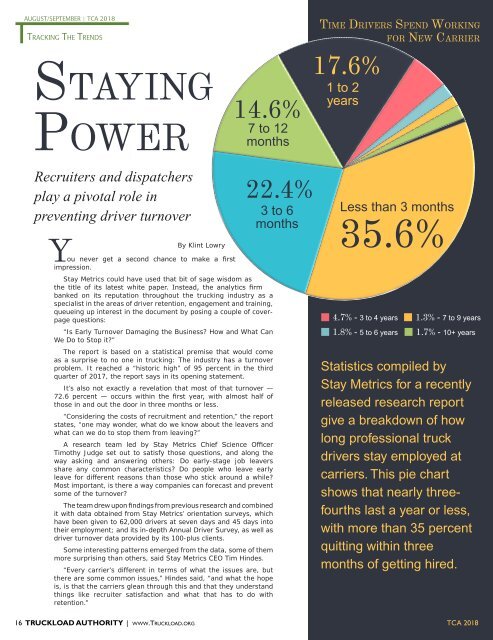Truckload Authority - August/September 2018
You also want an ePaper? Increase the reach of your titles
YUMPU automatically turns print PDFs into web optimized ePapers that Google loves.
AUGUST/SEPTEMBER | TCA <strong>2018</strong><br />
Tracking The Trends<br />
Staying<br />
Power<br />
14.6%<br />
7 to 12<br />
months<br />
Time Drivers Spend Working<br />
for New Carrier<br />
17.6%<br />
1 to 2<br />
years<br />
Recruiters and dispatchers<br />
play a pivotal role in<br />
preventing driver turnover<br />
Y<br />
By Klint Lowry<br />
You never get a second chance to make a first<br />
impression.<br />
Stay Metrics could have used that bit of sage wisdom as<br />
the title of its latest white paper. Instead, the analytics firm<br />
banked on its reputation throughout the trucking industry as a<br />
specialist in the areas of driver retention, engagement and training,<br />
queueing up interest in the document by posing a couple of coverpage<br />
questions:<br />
“Is Early Turnover Damaging the Business? How and What Can<br />
We Do to Stop it?”<br />
The report is based on a statistical premise that would come<br />
as a surprise to no one in trucking: The industry has a turnover<br />
problem. It reached a “historic high” of 95 percent in the third<br />
quarter of 2017, the report says in its opening statement.<br />
It’s also not exactly a revelation that most of that turnover —<br />
72.6 percent — occurs within the first year, with almost half of<br />
those in and out the door in three months or less.<br />
“Considering the costs of recruitment and retention,” the report<br />
states, “one may wonder, what do we know about the leavers and<br />
what can we do to stop them from leaving?”<br />
A research team led by Stay Metrics Chief Science Officer<br />
Timothy Judge set out to satisfy those questions, and along the<br />
way asking and answering others: Do early-stage job leavers<br />
share any common characteristics? Do people who leave early<br />
leave for different reasons than those who stick around a while?<br />
Most important, is there a way companies can forecast and prevent<br />
some of the turnover?<br />
The team drew upon findings from previous research and combined<br />
it with data obtained from Stay Metrics’ orientation surveys, which<br />
have been given to 62,000 drivers at seven days and 45 days into<br />
their employment; and its in-depth Annual Driver Survey, as well as<br />
driver turnover data provided by its 100-plus clients.<br />
Some interesting patterns emerged from the data, some of them<br />
more surprising than others, said Stay Metrics CEO Tim Hindes.<br />
“Every carrier’s different in terms of what the issues are, but<br />
there are some common issues,” Hindes said, “and what the hope<br />
is, is that the carriers glean through this and that they understand<br />
things like recruiter satisfaction and what that has to do with<br />
retention.”<br />
22.4%<br />
3 to 6<br />
months<br />
Less than 3 months<br />
35.6%<br />
4.7% - 3 to 4 years<br />
1.8% - 5 to 6 years<br />
Statistics compiled by<br />
Stay Metrics for a recently<br />
released research report<br />
give a breakdown of how<br />
long professional truck<br />
drivers stay employed at<br />
carriers. This pie chart<br />
shows that nearly threefourths<br />
last a year or less,<br />
with more than 35 percent<br />
quitting within three<br />
months of getting hired.<br />
9<br />
8<br />
7<br />
6<br />
5<br />
1.3% - 7 to 9 years<br />
1.7% - 10+ years<br />
4<br />
3<br />
2<br />
1<br />
16 <strong>Truckload</strong> <strong>Authority</strong> | www.<strong>Truckload</strong>.org TCA <strong>2018</strong>

















